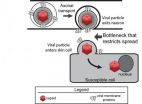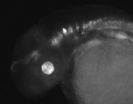(Press-News.org) Many animal species transmit information via chemical signals, but the extent to which these chemosignals play a role in human communication is unclear. In a new study published in Psychological Science, a journal of the Association for Psychological Science, researcher Gün Semin and colleagues from Utrecht University in the Netherlands investigate whether we humans might actually be able to communicate our emotional states to each other through chemical signals.
Existing research suggests that emotional expressions are multi-taskers, serving more than one function. Fear signals, for example, not only help to warn others about environmental danger, they are also associated with behaviors that confer a survival advantage through sensory acquisition. Research has shown that taking on a fearful expression (i.e., opening the eyes) leads us to breathe in more through our noses, enhances our perception, and accelerates our eye movements so that we can spot potentially dangerous targets more quickly. Disgust signals, on the other hand, warn others to avoid potentially noxious chemicals and are associated with sensory rejection, causing us to lower our eyebrows and wrinkle our noses.
Semin and colleagues wanted to build on this research to examine the role of chemosignals in social communication. They hypothesized that chemicals in bodily secretions, such as sweat, would activate similar processes in both the sender and receiver, establishing an emotional synchrony of sorts. Specifically, people who inhaled chemosignals associated with fear would themselves make a fear expression and show signs of sensory acquisition, while people who inhaled chemosignals associated with disgust would make an expression of disgust and show signs of sensory rejection.
To test these hypotheses, experimenters collected sweat from men while they watched either a fear-inducing or a disgust-inducing movie. The men followed a strict protocol to avoid possible contamination. For two days prior to the collection, they were not allowed to smoke, engage in excessive exercise, or consume odorous food or alcohol. They were also instructed to use scent-free personal-care products and detergents provided by the experimenter.
Women were then exposed to the sweat samples while performing a visual search task. Their facial expressions were recorded and their eye movements were tracked as they completed the task.
As the researchers predicted, women who were exposed to chemosignals from "fear sweat" produced fearful facial expressions, while women who were exposed to chemosignals from "disgust sweat" produced disgusted facial expressions.
The researchers also found that exposure to fear and disgust sweat altered the women's perceptions during the visual search task and affected their sniffing and eye-scanning behaviors in accordance with either sensory acquisition or sensory rejection. Importantly, the women were not aware of these effects and there was no relationship between the effects observed and how pleasant or intense the women judged the stimuli to be.
These findings are important, Semin and colleagues argue, because they contradict the common assumption that human communication occurs exclusively through language and visual cues.
Rather, the findings provide support for the embodied social-communication model, suggesting that chemosignals act as a medium through which people can be "emotionally synchronized" outside of conscious awareness.
The researchers acknowledge that these effects need to be investigated under conditions could very well contribute to the kinds of emotional contagion that is often observed in situations involving dense crowds.
### The study was co-authored by Jasper H. B. de Groot, Monique A. M. Smeets, Annemarie Kaldewaij, and Maarten J. A. Duijndam of the University of Utrecht.
This research was supported by a grant from Neuroscience and Cognition Utrecht (NCU).
For more information about this study, please contact: Gün R. Semin at g.r.semin@uu.nl.
The APS journal Psychological Science is the highest ranked empirical journal in psychology. For a copy of the article "Chemosignals Communicate Human Emotions" and access to other Psychological Science research findings, please contact Anna Mikulak at 202-293-9300 or amikulak@psychologicalscience.org.
The knowing nose: Chemosignals communicate human emotions
2012-11-05
ELSE PRESS RELEASES FROM THIS DATE:
Study supports move toward common math standards
2012-11-05
EAST LANSING, Mich. — A new study analyzing the previous math standards of each state provides strong support for adoption of common standards, which U.S. students desperately need to keep pace with their counterparts around the globe, a Michigan State University scholar argues.
Forty-six states are implementing the Common Core math and reading standards, which nonetheless have come under fire recently by some researchers and would-be politicians.
But William Schmidt, MSU Distinguished Professor of statistics and education, said the Common Core is a world-class set ...
Waste management -- good marketing
2012-11-05
This press release is available in Spanish.
Spanish legislation on waste management changed in July last year. Until then, the consumer was responsible for the disposal of products. According to Mr Unai Tamayo, economist at the University of the Basque Country (UPV/EHU), the new laws "foment the construction of closed systems, such as in taverns: the container being taken out and subsequently returned. Moreover, when a manufacturer launches a product on to the market, once consumed, the packaging is considered waste, and the responsibility for this now falls on the manufacturer ...
Princeton researchers identify unexpected bottleneck in the spread of herpes simplex virus
2012-11-05
VIDEO:
Princeton University research suggests that a common strain of herpes virus causes cold sores with only one or two viral particles, resulting in a bottleneck in which the infection is...
Click here for more information.
New research suggests that just one or two individual herpes virus particles attack a skin cell in the first stage of an outbreak, resulting in a bottleneck in which the infection may be vulnerable to medical treatment.
Unlike most viruses that ...
New research suggests standardized booster seat laws could save lives of children
2012-11-05
Boston, Mass, Nov. 5, 2012— A new study by researchers in Boston Children's Hospital's Division of Emergency Medicine indicates that a nationwide standard on booster seat laws for children 4 feet 9 inches and shorter, or up to 8 years old, would save lives. The findings were published online Nov. 5, 2012, in the journal Pediatrics.
Boston Children's researchers reviewed data from Fatality Analytic Reporting System, analyzing child deaths in motor vehicle accidents, looking specifically at whether the crash and resulting deaths or injuries took place in a state with or ...
Computers 'taught' to ID regulating gene sequences
2012-11-05
Johns Hopkins researchers have succeeded in teaching computers how to identify commonalities in DNA sequences known to regulate gene activity, and to then use those commonalities to predict other regulatory regions throughout the genome. The tool is expected to help scientists better understand disease risk and cell development.
The work was reported in two recent papers in Genome Research, published online on July 3 and Sept. 27.
"Our goal is to understand how regulatory information is encrypted and to learn which sequence variations contribute to medical risks," says ...
Superstorm animation
2012-11-05
A computer animation produced by University of Delaware researchers shows the explosive development of Hurricane Sandy, the superstorm and its unusual track. View the animation on the University's UDaily website at http://www.udel.edu/udaily/2013/nov/animation110212.html
Matt Shatley, computer research specialist in UD's College of Earth, Ocean, and Environment (CEOE), assembled the animation by digitally stitching together about 800 infrared images taken by GOES, the Geostationary Operational Environmental Satellite, which keeps a continuous eye on the continental United ...
Japanese family members less likely than others to give CPR for cardiac arrest
2012-11-05
Family members didn't give CPR for cardiac arrests as often as passers-by or friends in a Japanese study presented at the American Heart Association's Scientific Sessions 2012.
Cardiac arrest is the sudden loss of heart function, typically resulting from an abnormal heart rhythm that causes the heart to quiver erratically and stop pumping blood. According to the American Heart Association, effective bystander CPR provided immediately after sudden cardiac arrest can double or triple a victim's chance of survival.
In a review of 547,218 cardiac arrests occurring in 2005-09, ...
New device could allow your heartbeat to power pacemaker
2012-11-05
An experimental device converted energy from a beating heart to provide enough electricity to power a pacemaker, in a study presented at the American Heart Association's Scientific Sessions 2012.
The findings suggest that patients could power their pacemakers — eliminating the need for replacements when batteries are spent.
In a preliminary study, researchers tested an energy-harvesting device that uses piezoelectricity — electrical charge generated from motion. The approach is a promising technological solution for pacemakers, because they require only small amounts ...
Heart disease map of England highlights growing social inequality in older ages
2012-11-05
A study estimating the death rate from heart and circulatory disease in each electoral ward in England has found that despite considerable improvements since the 1980s, the difference between the wealthiest and poorest communities has widened for people over 65.
Mortality from heart and circulatory disease – the leading cause of death in the UK – declined in most places between 1982 and 2006, but for men and women aged 65 or older, the decline was smaller in the most deprived communities, resulting in a wider gap between rich and poor.
The authors, from Imperial College ...
Smallholder farmers need improved stake in Nile's development
2012-11-05
ADDIS ABABA (5 NOVEMBER 2012)—A new book finds that the Nile river, together with its associated tributaries and rainfall, could provide 11 countries—including a new country, South Sudan, and the drought-plagued countries of the Horn of Africa—with enough water to support a vibrant agriculture sector, but that the poor in the region who rely on the river for their food and incomes risk missing out on these benefits without effective and inclusive water management policies.
The Nile River Basin: Water, Agriculture, Governance and Livelihoods, published by the CGIAR Challenge ...



